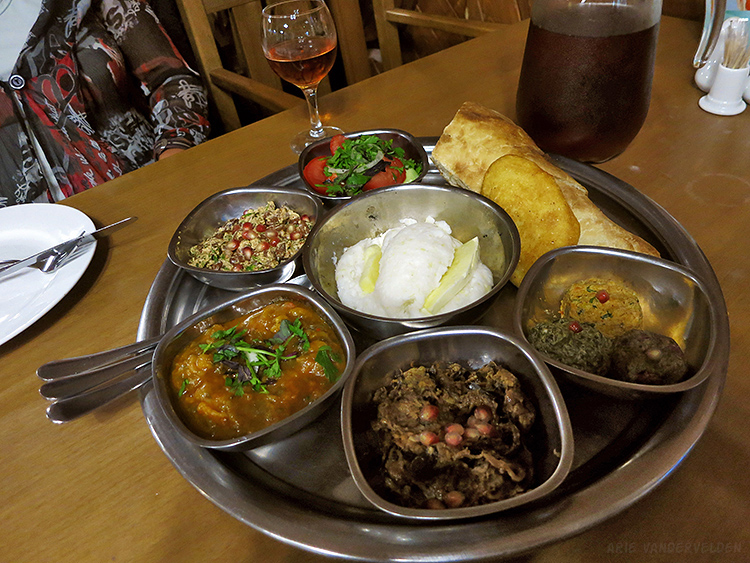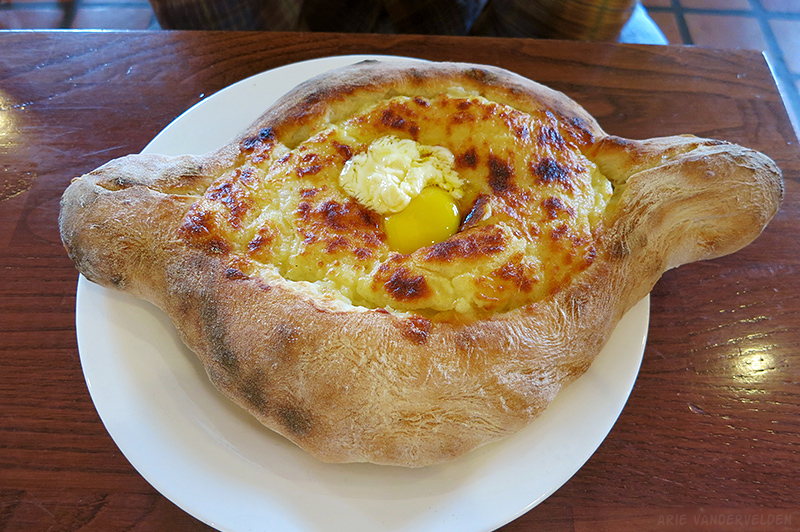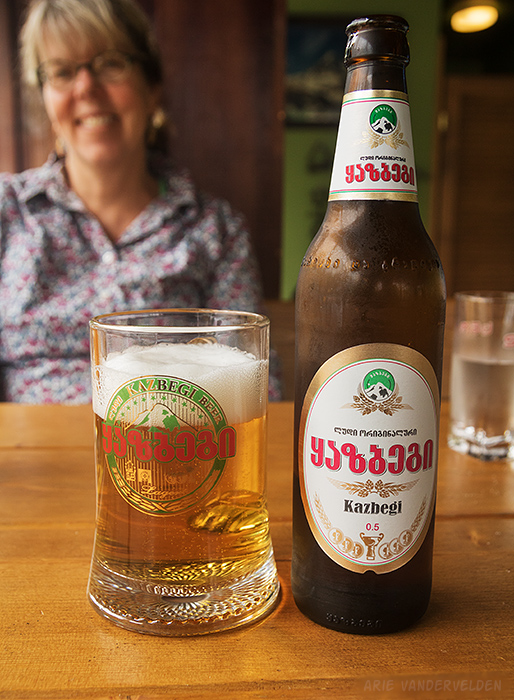One of the reasons why we traveled to the Republic of Georgia was to sample the food and drink here. We had heard about Georgia’s unique cuisine that fuses Persian, Central Asian, Turkish, and other influences.
When we arrived in Tbilisi we found a good restaurant that served traditional fare just downhill of our guesthouse. We started by ordering an appetizer platter.

Many of the items here hint at the Persian influence in Georgian cuisine. On the right are three different kinds of walnut paté. The salads and chutneys are richly flavoured with herbs and spices, and are garnished with pomegranate seeds. In the middle is polenta, with lots of butter.
One popular recipe we tried several times (and I’ve tried to make at home) is walnut paté spread on thin strips of eggplant, and then rolled up. Delicious!
The appetizer platter would have fed us both, but we had also ordered khinkali – Georgian dumplings. We weren’t sure how big they were, so we ordered four each of three different kinds. It turns out we had enough food to feed an army.

The khinkali hint at Central Asian influences, which is no accident given that Georgia is on the Silk Road. Inside are different kinds of spiced meats, somewhat similar to Chinese wontons. To eat the dumplings you bite into them, suck out the juices, and then you eat the rest. The twisted top where the dough comes together isn’t fully cooked, and that bit is discarded.

Next we wanted to try Georgian wine. To say that wine is sacred to Georgians is an understatement. It’s a source of national pride. Georgians claim to have invented wine about 8000 years ago, and recent archeological evidence supports that this is true.
Georgians, for their own consumption, make wine in clay vessels called qvevri. Crushed grapes, along with their skins and seeds, are put in these vessels and left to ferment naturally. Only after fermentation is the wine siphoned off of the sediment. This contrasts with western wine-making where the seeds and skins are separated before fermentation. The end result of qvevri-style wine making is an orange-coloured wine with a very different taste than a western wine.
We saw on the menu “one half liter” of wine for 6 Lari (about 2.5 Euro), which we figured to be “one half-liter”. However it turned out to be “one and one-half liters” of wine.

We ate and drank until we were stuffed and until our heads were spinning. It was fun. A great night out.
We rather like the taste of the qvevri wine. It’s very different than your classic white or red wine; it has a flavour all of its own. I’m not quite sure how to describe it in words. They are quite full-bodied. They don’t have the brightness, oakiness, or crispness of a white, yet don’t have the smokiness, red fruits or tannins of a red. I’m no wine expert but I thought I tasted hints of nuts and iced tea. Different, and very nice.
Georgians also make western-style wines. During the Soviet years Georgia exported vast quantities of semi-sweet, high-alcohol whites and reds to Russia. These days they cater more to global tastes. Some of the finest wines come from the Kakheti region, in eastern Georgia, from the foothills of the Caucasus Mountains.

We traveled to Kakheti to find out more about Georgian wine.
For desert, baklava is quite common.

Georgians have some hearty dishes for lunch. One that’s popular is called Khachapuri Adjaruli. It’s essentially a boat made out of pizza dough lined with salty cheese, and filled with melted butter and a runny egg in the middle. Heart-clogging cholesterol bomb? Sure it is. But it’s pretty tasty.

A more common version of Khachapuri is Khachapuri Imeruli, Georgian cheese pizza.

Khachapuri can be quite salty, and one way to combat this is to wash it down with a cold beer.

Finally there is a famous Georgian snack called churchkhela. They are walnuts threaded onto a string and dipped in thickened fruit juices. It’s essentially fruit leather stuffed with walnuts.

Aside from the starchy kinkhali and khachapuri, Georgian dishes also encompass vegetables and meats. We had a soup of unidentified green herbs with bits of meat, a stir-fry of meats and vegetables, and other dishes. In general our culinary experiences in Georgia were very much hit-and-miss; we picked some wonderful places and had some fantastic food, but we struck out a number of times as well. But, that’s the nature of travel….
